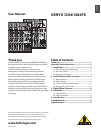
ENGLISH
XENYX 1204/1204FX User Manual
6
ENGLISH
XENYX 1204/1204FX User Manual
7
MUTE/ALT 3-4
You can use the MUTE/ALT 3-4 switch to divert the channel
from the main mix bus to the Alt 3-4 bus. This mutes the
channel from the main mix.
MUTE-LED
The MUTE LED indicates that the relevant channel is diverted
to the submix (Alt 3-4 bus).
CLIP-LED
The CLIP LED lights up when the input signal is driven
too high. In this case, turn down the GAIN control and, if
necessary, check the setting of the channel EQ.
SOLO
The SOLO switch (1204FX only) is used to route the channel
signal to the solo bus (Solo In Place) or to the PFL bus (Pre
Fader Listen). This enables you to monitor a channel signal
without affecting the main output signal. The signal you hear
is sourced either before (PFL, mono) or after (solo, stereo)
both the pan control and the channel fader (see chapter
2.3.6 “Level meters and monitoring”).
The channel fader determines the level of the channel signal
in the main mix (or submix).
Stereo channels2.2
Channel inputs2.2.1
Stereo channel inputs and LEVEL switchFig. 2.5:
Each stereo channel has two balanced line level inputs on
¼" connectors for left and right channels. If only the
connector marked “L” is used, the channel operates in
mono. Stereo channels are designed to handle typical line
level signals.
Both inputs can also be used with unbalanced jacks.
LEVEL
For level matching, the stereo inputs feature a LEVEL switch
which selects between +4 dBu and -10 dBV. At -10 dBV
(home-recording level), the input is more sensitive than at
+4 dBu (studio level).
Equalizer stereo channels2.2.2
The equalizer of the stereo channels is, of course, stereo. The
filter characteristics and crossover frequencies are the same
as those of the mono channels. A stereo equalizer is always
preferable to two mono equalizers if frequency correction
of a stereo signal is needed. There is often a discrepancy
between the settings of the left and the right channels when
using separate equalizers.
Aux sends stereo channels2.2.3
In principle, the aux sends of the stereo channels function
in just the same way as those of the mono channels. As aux
send paths are always mono, the signal on a stereo channel
is first summed to mono before it reaches the aux bus.
Routing switch, solo and channel fader2.2.4
BAL
The function of the BAL(ANCE) control corresponds to the
PAN control in the mono channels.
The balance control determines the relative proportion
between the left and right input signals before both signals
are routed to the main stereo mix bus.
The MUTE/ALT 3-4 switch, the MUTE-LED, the CLIP-LED, the
SOLO switch and the channel fader function in the same way
as the mono channels.
Connector panel and main section2.3
Whereas it was useful to trace the signal flow from top to
bottom in order to gain an understanding of the channel
strips, we now look at the mixing console from left to right.
The signals are, so to speak, collected from the same point
on each of the channel strips and then routed to the main
section all together.
Aux sends 1 and 2 2.3.1
AUX SEND controls of the main sectionFig. 2.6:
A channel signal is routed to aux send bus 1 if the AUX 1
control is turned up on the corresponding channel.
AUX SEND 1 (MON)
The AUX SEND control MON acts as master control for aux
send 1 and determines the level of the summed signal. In the
1204FX, the MON control is called AUX SEND 1.
AUX SEND 2 (FX)
Similarly, the FX control (AUX SEND 2) determines the level
for aux send 2.
SOLO
You can use the SOLO switch (1204FX only) to separately
monitor the aux sends via the CONTROL ROOM/PHONES
outputs and check these with the level meters.
If you want to monitor the signal of just one AUX bus, ◊
none of the other SOLO SWITCHES should be pressed
and the MODE switch must be in the SOLO position
(not pressed down).
Aux send connectors 1 and 22.3.2
Aux send connectorsFig. 2.7:
AUX SEND 1
If you use aux send 1 pre-fader, you would usually connect
the AUX SEND 1 connector to monitors via a power amp (or
an active monitor system). If you use aux send 1 post-fader,
proceed as described under aux send 2.
AUX SEND 2
The AUX SEND 2 connector outputs the signal you picked
up from the individual channels using the FX control. You
can connect this to the input of an effects device in order to
process the FX bus signal. Once an effects mix is created, the
processed signal can then be routed from the effects device
output back into the STEREO AUX RETURN connectors.
Stereo aux return connectors2.3.3
Stereo aux return connectorsFig. 2.8:
STEREO AUX RETURN 1
The STEREO AUX RETURN 1 connectors generally serve as the
return path for the effects mix generated using the post-
fader aux send. This is where you connect the output signal
of the external effects device. If only the left connector is
used, the AUX RETURN automatically operates in mono.
You can also use these connectors as additional ◊
line inputs.
STEREO AUX RETURN 2
The STEREO AUX RETURN 2 connectors serve as the return
path for the effects mix generated using the FX control.
If these connectors already function as additional inputs,
you can route the effects signal back into the console via a
different channel, with the added benefit that the channel
EQ can be used to adjust the frequency response of the
effects return signal.
In this instance, the FX control of the channel being ◊
used as an effects return should be turned fully
counterclockwise, otherwise feedback problems
could occur!
If you wish to use the internal effects processor, no ◊
connectors should be plugged into STEREO AUX
RETURN 2.
Stereo aux return2.3.4
Stereo aux return controlsFig. 2.9:
STEREO AUX RETURN 1
STEREO AUX RETURN 1 is a stereo control which determines
the level of the signal in the main mix. If STEREO AUX
RETURN 1 is used as effects return, you can add the effects
signal to any “dry” channel signal.
In this instance, the effects device should be set at ◊
100% effect.
STEREO AUX RETURN MON
The STEREO AUX RETURN MON control has a special function:
it can be used to add an effect to a monitor mix.
For example:
Monitor mix with effect
In this instance, the effects device should be set up as
follows: AUX SEND 2 is connected to the L/Mono input
of your effects device, while its outputs are connected
to STEREO AUX RETURN 1. Connect the amplifier of your
monitor system to AUX SEND 1. The AUX SEND 1 master
control determines the volume of the monitor mix.
You can now use the STEREO AUX RETURN MON control
to adjust the level of the effects signal routed to the
monitor mix.
You can easily use the headphones distribution amplifier
BEHRINGER POWERPLAY PRO HA4600/HA4700/HA8000
to provide you with four (or eight with the HA8000) stereo
headphone mixes for your studio.
STEREO AUX RETURN 2 (FX)
The STEREO AUX RETURN 2 control determines the level of
signals fed into the AUX RETURN 2 connectors which are
routed to the main mix.
MAIN MIX/ALT 3-4
The MAIN MIX/ALT 3-4 switch routes the signal connected to
STEREO AUX RETURN 2 to either main mix (not pressed) or
submix (Alt 3-4, pressed).













